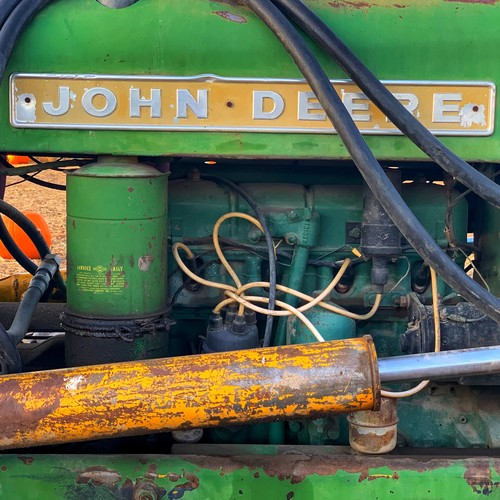GPS-enabled tractors outfitted with LTE currently help farmers plant more seeds. But 5G could offer even more tools, making it possible to increase food production around the world.

Moline, Illinois-based John Deere packs a lot of technology into its tractors. In fact, in some ways John Deere more closely resembles a tech company than it does an agriculture firm. The company hopes to use its expertise in both agriculture and technology to improve current farming practices and increase food production around the world.
While that might sound like a lofty goal, John Deere is already using 4G technology and GPS to make farmers more efficient. The company currently offers GPS-directed tractors that, when coupled with the company's correction technology, can steer to within an inch of where the tractor needs to be, allowing for very precise seed planting. According to the company, a single John Deere tractor and planter can precisely plant more than 700 corn seeds and 2,800 soybean seeds every second.
20 years of self-driving experience
Although the company's GPS-enabled tractors are self-driving, a human operator is still required to be in the cab. "We've been doing this for 20 years. It started out simply driving with straight tracks," said Lane Arthur, vice president of data, applications and analytics at John Deere. Arthur said he recently spoke with one of John Deere's customers in North Dakota who told him that he didn't have to touch the steering wheel in the tractor for more than four hours. "He only had to stop to add more seeds," Arthur said.
John Deere tractors are outfitted with an LTE modem on top of the tractor cab. That modem is used to transmit data that the tractor collects as it moves across the field. The amount of data is extensive: For example, John Deere's highly automated 8RX tractor with a 60-foot, 24-row planter has more than 300 sensors and 140 controllers, which can process 15,000 measurements per second per machine.
Once the data is collected and sent to the cloud, it is used for analysis. "When we pass over the field, we ship a lot of information into the cloud," said Nancy Post, director of the embedded software and solutions group at John Deere. "Each time we pass over a field, we make the tractor smarter."
Deere's cloud provider is Amazon Web Services, which is where its cloud applications are stored. Once the data from the fields is shipped to the cloud, farmers can access the information through the John Deere Operations Center, an application that shows farmers how each field performed. Farmers can compare data from different years and also see how weather events may have impacted their crops. "We process the data in the cloud and then deliver it to the farmer on a web or mobile device," Post said.
Not only does the LTE modem collect data about the crops and the farmer's yield, it also can collect data about the tractor. Post said that customers can use the LTE modem to remotely connect to their tractor dealer and get help with their setup or even handle maintenance of the tractor. The ability to do long-distance maintenance was particularly critical in 2020 because of the COVID-19 pandemic. "Customers needed help from their dealers but didn't want them in the tractor cab," said Post. "We could remotely connect and help them." Post added that the usage of this option increased 200% in 2020 because of the pandemic.
Connectivity is critical
But not all rural areas of the US have adequate wireless coverage, let alone 4G coverage. Arthur said that's why John Deere has been working with the FCC to improve rural broadband coverage. Last fall the FCC approved a $9 billion 5G fund for rural America, which is intended to improve wireless access, and $1 billion has been set aside specifically to improve precision agriculture technology. The money will be distributed through FCC auctions at some point in the future.
"We do have issues with coverage and reliability in rural areas," Arthur said. "We are working with the government and wireless carriers to increase that connectivity and reliability."
Post said that when a farmer doesn't have adequate coverage in the fields, the tractor will still collect data and store it until it has adequate connectivity to send the data to the cloud. However, the amount of data is fairly significant. Arthur said that, on a typical day of spring planting, John Deere processes 5 to 15 million sensor measurements every second – that's more than 100MB of data per second being delivered to the Deere data platform in the cloud.
5G aspirations
Although John Deere's tractors currently work with LTE, the company does intend to incorporate 5G in future tractors. The lower latency and additional bandwidth that 5G promises will make it possible for farmers to eventually have fully autonomous tractors without a human operator. However, to get to that point, the tractor will have to transmit a tremendous amount of data that will need to be processed quickly and accurately.
Having fully autonomous tractors will allow farmers to know exactly what is happening in their fields in real-time without having to actually be on the tractor.
Besides working with operators to gain more widespread 5G coverage for its connected tractors, John Deere also is planning to build private 5G networks using wireless spectrum licenses that it won last fall in the FCC's CBRS spectrum auction. The company paid around $550,000 for five licenses in counties in Illinois and Iowa, and it plans to use those licenses to build 5G private networks in 2022 and use them for its manufacturing and application development.
— Sue Marek, special to Light Reading. Follow her @suemarek.
About the Author(s)
You May Also Like










